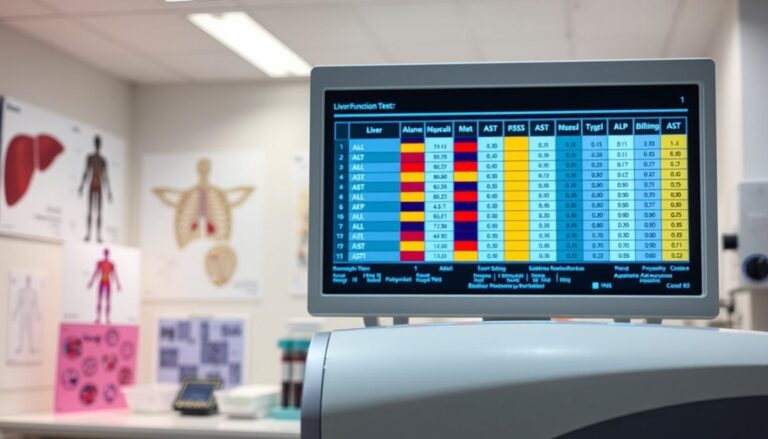How to Read Your Lab Test Results: A Patient’s Complete Guide
Ever wondered what your lab test results really mean? How can you use this info to take charge of your health? Thanks to a 2014 rule, you can get your lab test results directly from the lab. Knowing what your lab test results say is key to making smart health choices.
By learning to read and understand medical test results, you can grasp your health better. This lets you work with your doctor to create a solid treatment plan. It’s all about making sense of test findings and lab reports to know your health inside out.
Understanding lab test results is crucial in today’s healthcare world. These results guide about 70% of doctor’s decisions. From blood counts to metabolic panels, each test tells us something important about our health.
By learning about your lab test results, you can be more involved in your healthcare. This way, you can make choices that are best for you at our diagnostic centre in Yelahanka, we provide accurate and timely lab tests to help you stay informed about your health.

Essential Components of Laboratory Test Reports
When you get your lab test results, it’s key to know what each part means. Understanding the report helps you grasp the findings. It includes patient info, test names, and what’s considered normal.
Decoding lab results means looking at them against the normal ranges and units. This helps you understand what the numbers mean.
To make sense of test results, you need to know how to interpret lab reports. Medical tests are analyzed based on your health history and other factors. Getting your test results right is crucial for proper diagnosis and treatment.
Patient Demographics and Identification
Knowing your name and ID number is important. It makes sure the results are for the right person.
Test Names and Collection Dates
Test names and when they were done are key. They tell you what tests were run and when the samples were taken.
Reference Ranges and Units
Reference ranges and units are crucial for understanding results. They help you see if your numbers are normal. Knowing these helps you understand your health better.
By knowing what lab reports mean, you can be more involved in your health. This helps you make better choices about your care.
| Test | Reference Range | Units |
|---|---|---|
| White Blood Cell Count | 3.5-10.5 billion cells/liter | cells/liter |
| Red Blood Cell Count | 4.32-5.72 trillion cells/liter (men), 3.90-5.03 trillion cells/liter (women) | cells/liter |
How to Understand Lab Test Results and Their Meanings
Understanding lab test results is key for patients to make smart health choices. It can be tricky to analyze test results, but knowing what they mean is empowering. It helps people take charge of their health.
First, it’s important to grasp the reference ranges and units. For instance, a hemoglobin (Hgb) test ranges from 12-18 g/dL. A hematocrit (Hct) test ranges from 37-52%. Here are some lab test results to know:
- Hemoglobin (Hgb): 12-18 g/dL
- Hematocrit (Hct): 37-52%
- Red blood cell (RBC) range: 4.2-6.1 million/mcL
- White blood cell (WBC) normal range: between 2,500 and 6,000 for ANC
Knowing these results helps patients and doctors make better health decisions. It empowers individuals to manage their health effectively.
It’s vital to analyze and understand test results. By working with healthcare providers, patients can manage their health better. This way, they can make informed choices about their well-being.
| Lab Test | Normal Range |
|---|---|
| Hemoglobin (Hgb) | 12-18 g/dL |
| Hematocrit (Hct) | 37-52% |
| Red blood cell (RBC) | 4.2-6.1 million/mcL |
Common Laboratory Values and What They Indicate
Understanding blood work results is key. Knowing the different tests and their ranges is crucial. It helps patients manage their health better. Learning about laboratory values is the first step in decoding medical test results.
Common values include blood counts, metabolic panels, lipid profiles, and hormone levels. For example, a high white blood cell count might show an infection. A low hemoglobin level could mean anemia. Knowing these can help spot health problems early.
Blood Count Parameters
Blood count values like hemoglobin and white blood cells are important. Hemoglobin ranges from 12-16 g/dL for women and 14-18 g/dL for men. White blood cells should be between 4-10 x 10^9/L.
Metabolic Panel Results
Metabolic panels give insights into metabolic health. Glucose levels should be 70-99 mg/dL. Sodium levels should be 136-145 mEq/L.
Knowing these values helps patients understand their test results. It’s important to interpret blood work, decode medical tests, and understand laboratory results. Patients should carefully read their test data to stay healthy.
| Test | Normal Range |
|---|---|
| Hemoglobin | 12-16 g/dL (female), 14-18 g/dL (male) |
| White Blood Cells | 4-10 x 10^9/L |
| Glucose | 70-99 mg/dL |
| Sodium | 136-145 mEq/L |
Conclusion: Taking Control of Your Health Through Informed Understanding
Understanding our lab test results helps us take charge of our health. This article has shown us how to read lab test reports. We learned about patient demographics, reference ranges, and units.
We also learned about common lab values like blood counts and hormone levels. Knowing these details helps us make better health choices.
Talking to our healthcare providers is crucial. We should ask them about our lab results. This way, we can work together to manage our health.
Being knowledgeable about lab results empowers us in our healthcare journey. It helps us understand and make informed decisions about our health.







